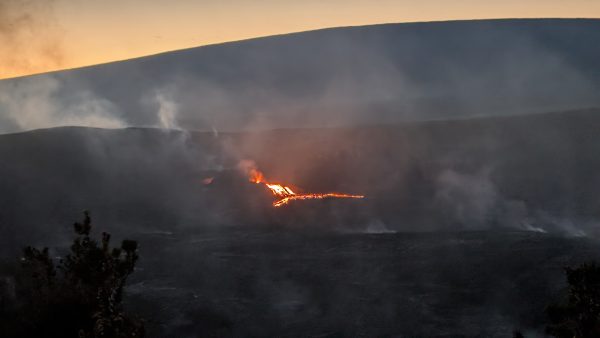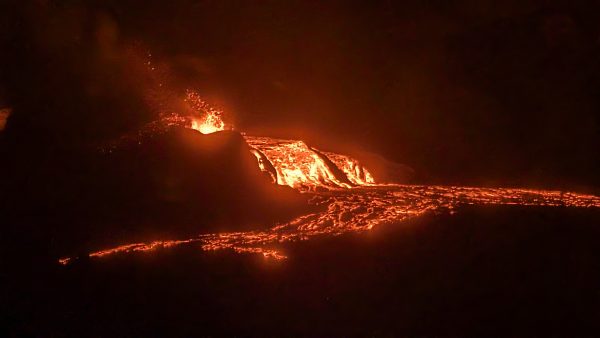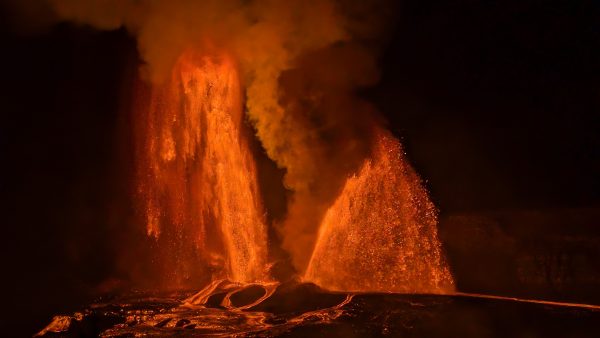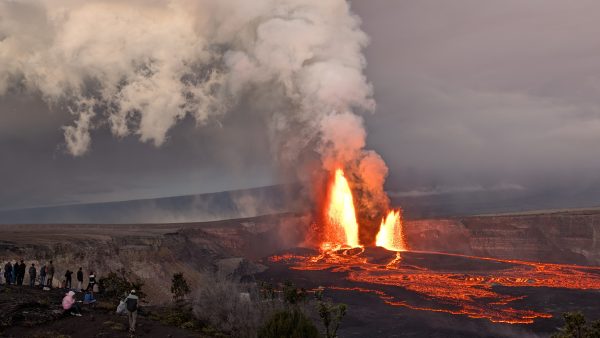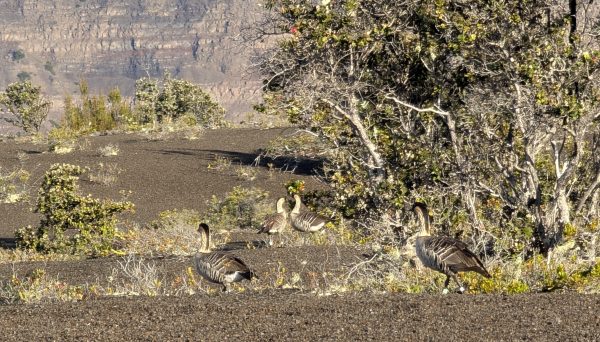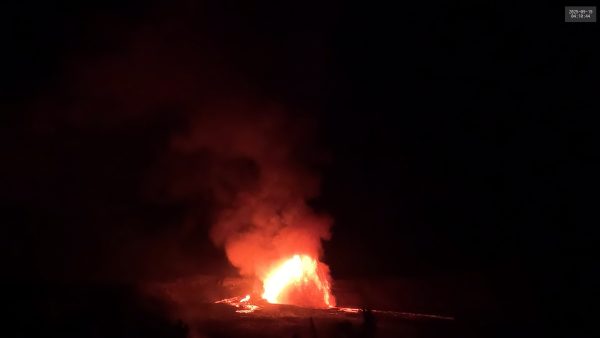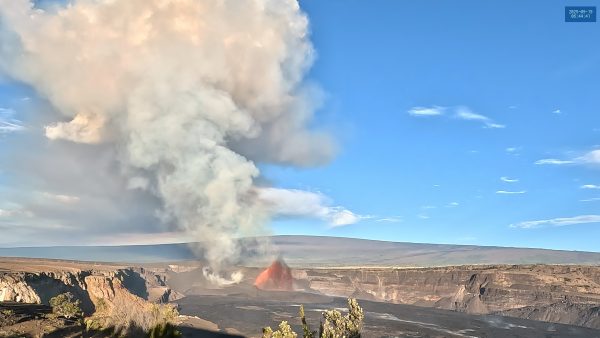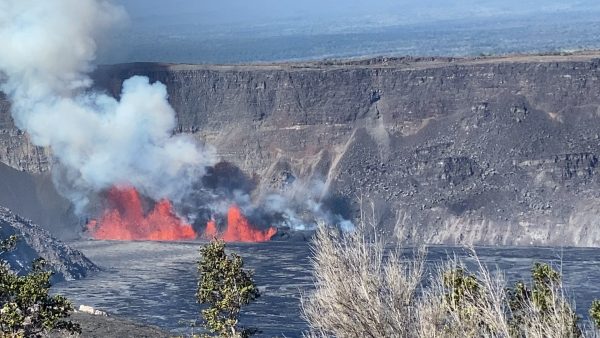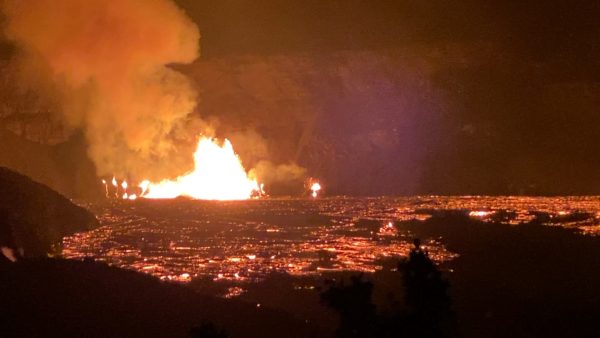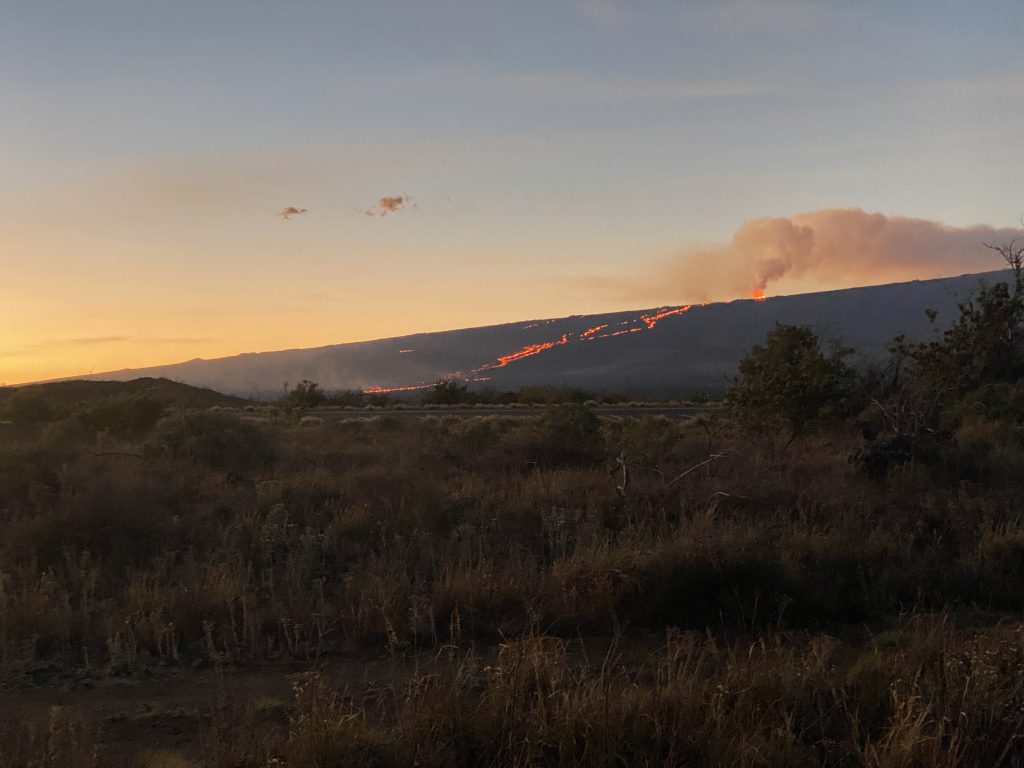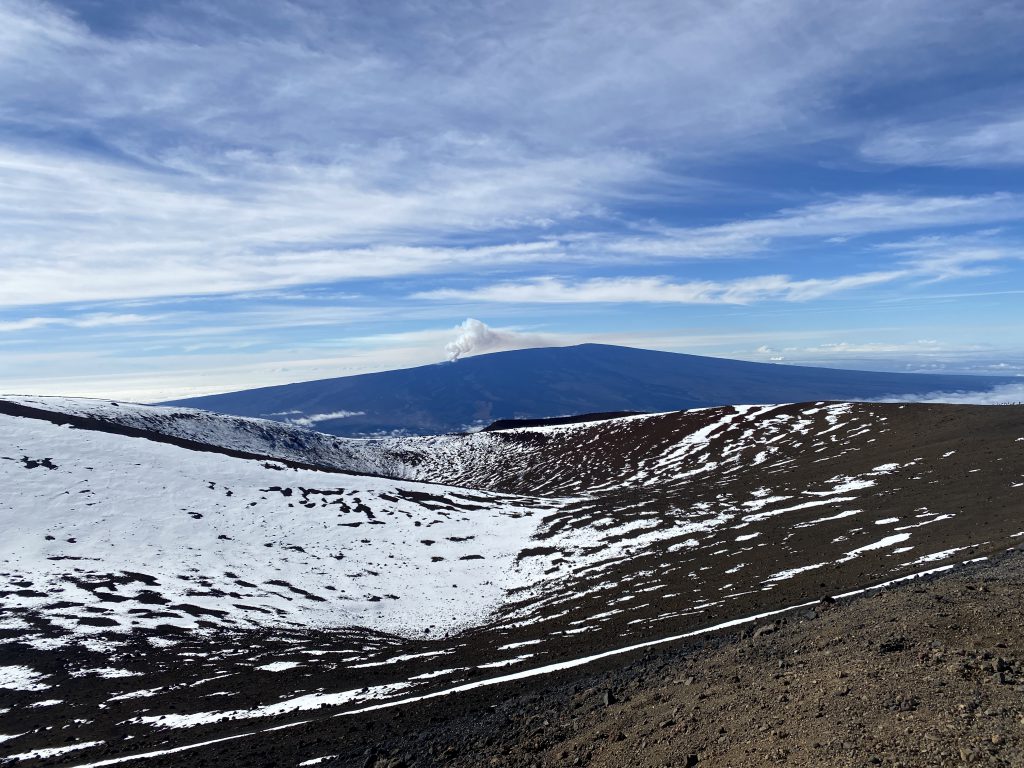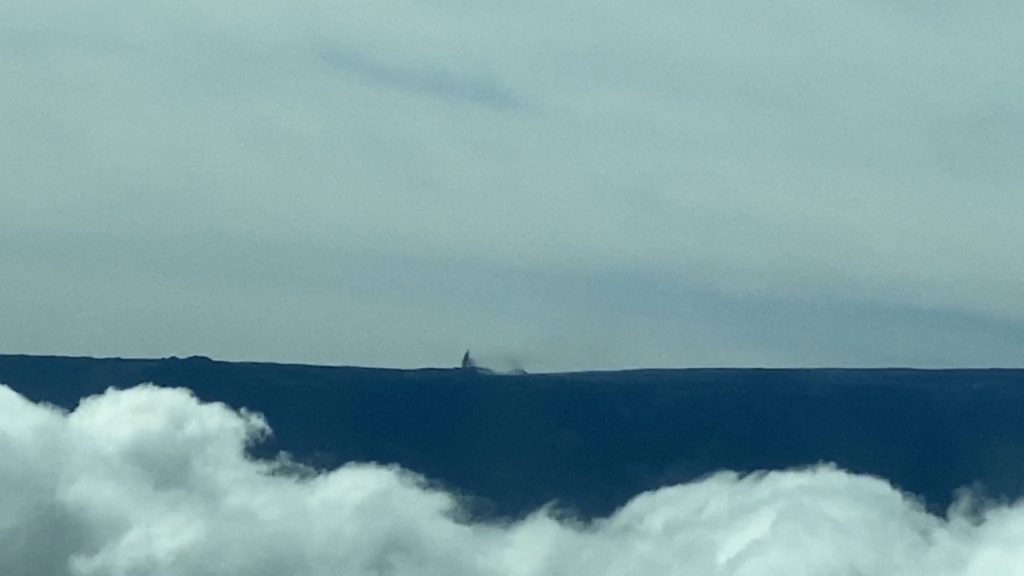Posted on
Category: Kilauea
Posted on
Posted on
Kilauea Eruption, Episode 34, 2025 October 01
The wait, despite the shorter expected interval, was longer this time. It started with the first visible pooling of the lava on the webcam at 2000. We continued to watch until we saw overflow at around 2145. Decided it was time to head over and start observing in person.
Arrived shortly before 2300, and did not witness another overflow until 0215. There was another almost two hours later. it was fairly strong, and lasted around 11 minutes.
The intervals were about one hour apart until 0700, with longer durations, when they started to decrease. By 1530, they had dropped into the 6 to 8 minutes range. This was starting to look the preliminary activity before the previous eruption.
All of these overflows seemed to have the effect of slowing raising the lip and bottom of the lava waterfall, with the bottom rising faster. There seemed to be less distance between the two by the time of the eruption start.
This state of affairs continued until 2100, when I decided to head back to the parking area and do some watching via webcam, which actually had a better view of the vent when it came to details.
The lot was full, but there was some turnover. A lot of the vehicles were running their engines, i guess because it was humid and foggy, and if you didn't open the windows, it fogged up inside.
The overflows stopped by the time I got to the car, and after several hours of absolutely nothing happening, Suzanne also returned and we went back to our accommodations to eat, recharge dead batteries and get a little sleep.
it was now well into 30 September, which was supposed to be our last full day of the trip. We had the webcam on the wall screen the whole time, and nothing continued to happen until noon approached. By then we decided to return to the parking lot to secure a space, if any were available.
We wasted some time since the overflows were still intermittent. The parking lot had a number of empty spaces when we arrived, but these were slowly filling up. The people started using the parallel spaces, and we decided it was time to return to the overlook.
We managed to replace our previous view spot, as there weren't many there. I didn't notice anyone who looked like they were waiting like we were, as we had the only chairs out there.
The second round of overflow ended around 1900. A couple of hours later I did as the night before, headed back to the car to reconfigure. Dozed off and just before midnight decided to check the camera again. There was heavy overflow from the vent, so called Suzanne to find out when it started. She said she was about to call me. I quickly got myself together, and a half hour later was back out. The sky was glowing red for the last half of the mile walk.
For the next half hour the flow did not let up, and then it seemed like the doming over the vent was turning to jetting. The USGS start of the eruption was put at 0053. For the next hour the height of the jetting got taller, surpassing the height we had seen in the previous eruption. Then at just before 0145, the glow in the South vent began to get brighter. First lava poured out, then it too began jetting. Within a couple of minutes its height was greater than that of the North Vent. And it continued to get higher.
At their best, I was estimating 240 to 300 m/800 to 1000 ft for the North Vent, and 350 to 450m/1200 to 1500 ft for the South. I've not seen a report for the North, but the USGS put the south at 1300ft, so my estimates were in range.
With the eruptions so tall, there was little liquid lava running down the slopes. Instead there was a stead rain of solidified lava. At times the jets were obscured by a curtain of this material. We could also see it being swept upwards by the convection current, which made height estimation a bit difficult.
With two lava columns, we could feel a bit of warmth coming from that direction, surprising considering the distance.
It wasn't until about 0400 that it started to look like the height was decreasing. Around 0530 I thought that the power of the columns was decreasing, but they kept coming back.
By then it was getting light. The night started out clear, but as it got lighter, the clouds turned to mist. It never turned into rain, but the area got wet.
Finally, around 0650 it be came obvious that the end was near. The South vent height dropped rapidly, ending at 0700. The North Vent continued for another three minutes before it also quit.
For the first few hours the crowd was well behaved. Around 0300 the Asian selfie mobs started to appear. At one point the took over a huge area beyond the rope boundary to the left of us, and proceeded for the next hour to prance around making idiotic poses and gang gestures. It got kind of tiring to see these same gestures over and over by people who seemed to be under the impression they were being witty and original. At a couple of points we had to yell at some of the selfie gaijin, as they were stop waving their overly bright lights in our direction, or getting too close to the cliff edge slope. I came to the conclusion that the best way to describe these people is that "they were not here to see the volcano erupt, but to be seen at the volcano eruption". It would have been easier and cheaper, in both time and money, so do their antics in front of a large screen projector. (I hope and expect to see so-called AI created selfies in the near future. Then maybe the selfie plague will end when no one will believe you were there.)
Just before the eruption ended, at dawn, a flock of nene (Hawaiian geese) flew behind us. As in Yellowstone, it appears they commute into an area in the morning, hang around for the day, then disappear at sunset. We saw them (with multiple tourists getting too close) on our way back to the parking lot.
The order of events we saw were quite similar in both eruptions we saw, but more drawn out this time, despite the shorter interval. At times it seemed the volcano was deliberately going slow to make sure we could not make our original travel plans for home. As it was, the eruption started after our deadline for leaving. Fortunately, we had alternate flights booked, and were easily able to extend the car rental. It was midday after the eruption ended when we were able to find a place to stay.
On the evening of 02 October, I felt the 3.7 earthquake at 2029 located just south of Pahala. It was like the rumbling for a second of a piece of heavy equipment (electric generator, for example) starting up. Outside, the frog noises, which are loud and constant much of the night, decreased for a moment or two. Suzanne didn't feel a thing.
Posted on
Kilauea Eruption, Episode 33, 2025 September 19
Since the last visit in December, what can be seen of the volcano has changes, as the level inside the crater has come up considerably, and the vents are now at the top of a large cinder cone. Spent a couple of days checking out the various viewpoints to determine which one best suited our needs. The viewpoint off the old Crater Rim Road before from the Keanakako'i Crater still seemed the best, although just down the road across from the crater seemed possible.
Across from the Kilauea Military Camp along the rim, between the trees, were a number of viewpoints with direct views at the vents, but these would view an inclined eruption column head on. It was from one of these at around 0838 on the morning of 17 September that we saw the first lava overflow for the upcoming eruption episode. Saw two from there, indicating that it was time to start paying attention.
We arrived around midnight to start 18 September. We decided to try the farther overlook, to stay away from the crowds at the main overlook. We had the area to ourselves, and started watching the overflows. The overflows were quite consistent, lasting about two minutes and occurring every seven to nine minutes. This location was a bit breezy, and during much of the night until dawn it was damp from a consistent mist that never really turned into rain.
Around noon the overflows stopped. We returned to the car and the parking lot to get out of the wind for a while. A couple of overflows around 1400 got us back out, but these overflows again stopped, with nothing going on until sunset. We decided to go back to the car to get a nap and wait for something to happen. By 2100, nothing had, se that was when we decided that we needed to return to our cabin to rest up, have something to eat, and recharge our various powered devices. Put the V1 webcam view on the wall screen and waited.
Around midnight (again) we saw the first lava overflow since sunset, and knew it was time to head out. The parking lot was half empty, which was a pleasant surprise. We had thought that there would be a considerable number of people waiting. Decided that were we had waited the day before was too windy and exposed, and would need to join the rest of the crowd. We left our cabin at 0100, arrived at the parking lot 15 minutes later, and walked out to the main overlook, arriving around 00:45. The overflow had continued, or restarted before we arrived. (The glow was consistent on the walk out.) We found the rope line pretty much filled with people waiting. Found a spot that gave us an unobstructed view, and started another wait.
This time the overflows were more irregular and longer. A couple of hours later we got the strongest one yet, and it looked as if it was finally going to go into a full eruption. The USGS start time was 0311, but from our point of view it had started well before that.
Unlike a geyser, where the maximum height is near the start. This eruption took its time, at least a half hour, to slowly reach full height. For this eruption, that height seemed around 225m/750ft, and it stayed there for several hours.
Several times during this period, starting at 0400, the South Vent started to overflow, then well up strongly for a minute or two. It looked like it too was about to start erupting, but it never did. By dawn this activity had subsided.
Before dawn there was an influx of people who seemed to only be there to take selfies, no matter what the volcano was doing, so they got lucky to see an eruption. By sunrise most of the people waiting overnight had left.
Just before noon the South Vent overflowed again, the first time in daylight. With the second overflow, it seemed apparent that the eruption was ending. Over a matter of a couple of minutes the North Vent eruption height dropped, and then it quit.
People applauding the end of an eruption is not just a Yellowstone Grand Geyser phenomena. That happened with the end of this eruption.
There seemed to be a large contingent of people arriving just after the eruption ended. Overheard a few mentioning that they were staying at resorts in the Kona area, which is well over two hours drive away. So I would suspect these are people who hadn't intended to be hear, but in the morning heard of the eruption and headed over, leaving at the start of Tourist Hours (1000-1700), arriving just in time to miss everything.
Posted on
Kilauea Eruption, Episodes 1 & 2, 2024
For our latest trip to the Island of Hawaii, Kilauea was quiet, and we didn't expect to spend much time in the vicinity. We did spend several days staying at Volcano, where, surprisingly, we never got any rain lasting more than a few minutes. Most of the time spent in the Volcanoes National Park was to see some nene who were frequenting the Pu'upua'i parking lot.
So it was a complete surprise when, on 23 Dec, our next to last day of the trip, we were awakened in the early hours by reports of new erupting activity. Unfortunately, we were staying in Kohala, well over a two hour drive from Kilauea. We got organized as best we could, and headed out just before dawn, at which point the eruption had been going for at least four hours. We took a break in Hilo to fill the gas tank on the car, then made a decision to try and stay an extra day. Turned out to be easier than expected. From the Safeway parking lot, we were able to get a flight out corresponding to our original flight, just 24 hours later. The auto rental company had an automated system that quickly allowed the addition of an extra day. As for where to stay, we'd worry about that later.
As we approached Volcano, we could see the smoke plume from the crater directly in front of us.
We arrived at the Devastation trailhead parking lot around 09:00, where there were still a few open parking spaces. A few days earlier that lot was empty (including nene). Hiked out to the overlook, passing a number of people who were headed in. Practically from the parking lot we could hear the sound of the eruption. At the overlook there wasn't much of a crowd, and there were spaces available for viewing along the rope line.
On the far wall (I later determined this to be about 2.4km/1.5 miles away) were three large lava fountains. Based on the time it took for rocks to fall from their peak, we estimated the activity was at least 80m/275ft high. The lava was bright orange, but the lava lake was mostly crusted over and black. There were a few red cracks visible. These kept changing throughout our time there, and occasionally there was small spurts of red from one of them.
The roaring from the vents varied, and with the distance, it was almost impossible to correlate the activity with the sound.
By the time we left, about six hours later, the weather had deteriorated a bit. It was getting windy and damp, and it was also time to visit the vault at the trailhead. The hike takes about 20-25 minutes, and by the time we got to the car, it had started to actually rain a bit. Not sure what to do, we decided that the rain would be less at the overlook, and while that was true, it was still wet. We headed back to the overlook. The rain and humidity also meant that the crater was now a bit foggy. The activity also seemed to have gotten smaller.
By then we had to make some decisions. Mostly where to stay and how to check out of our place in Kohala. We decided that it made sense to drive back then, pack up and then drive back for some nighttime observations. We could be checked out at least, and worst case, end up sleeping in the car.
As it turned out, the eruptive activity quieted down by the time we reached Hilo, about a half hour later. That was a bit of a relief, as the pressure to put in a lot of driving was now gone, and we knew we weren't missing anything (except seeing the end). We made it back to our place around sunset, and found out that our hosts did not have anyone staying the next night, and were willing to extend us a day, into Christmas. (They also helped our food situation with a gift of some of the day's fish catch, which grilled up nicely.)
So we got a good night's sleep, and the next morning found that there was still no activity. That being the case, we went ahead with what had been our plans for yesterday. That meant going to a location with poor to no cell service, where Suzanne went snorkeling. The day was hazy from the smoke and particles put out by Kilauea, in contrast to the nice clear skies we'd had for the past two weeks. And we did get a bit more organized, just in case.
It was there, shortly after noon, that we learned that the activity had restarted. Time for another change of plans. We went back to our accommodations, about twenty minutes away, and packed up as if we were checking out. If the activity died down again, we could always drive back for a nap, but we believed we were not going to be back, and would be spending the night at the volcano. We were packed up and on the road by 15:00
We arrived back at sunset (about 17:30) and things had changed. The parking lots were jammed, but fortunately we were able to park alongside the road just outside the Devastation parking lot. (As long as you weren't over the white fog line, the NPS didn't care. The day before we did see a few citations handed out to cars blocking the traffic lane.)
The crowd was four deep this time, and spilling over beyond the rope line. I decided that I wanted to see something and joined them for a short time. By then, someone shout out that the NPS was ticketing people, and the crowd quickly got legal, at least for a while.
The activity was comparable to the previous day, but different vents were activity. The most active the previous day was now quiet, with only the middle vent jetting to about 60 meters high. As it got darker, the crowd thinned enough that we were able to finally end up on the rope line and not be blocked in our views.
A lot of people sitting on chairs, for example, left about then, which I found surprising, as nighttime can be fairly spectacular. Only once did we have Skype calls inflicted on us, and a couple had to call all their family members, it being Christmas eve. There were also a lot of people who force their way over the rope line, snap their selfies (using a flash to make sure their pose was visible) and then leave. Later in the night there was one couple who spent the better part of half an hour getting that perfect pose.
The wind started out pretty calm, but picked up once it got completely dark. With the temperature in the low 50s, it made for some discomfort at times.
By midnight things had quieted down a lot, although there was a sudden uptick in people about a half hour later. Probably residents driving up for a quick Christmas selfie. In any case, by about 02:00 we decided we needed to visit the vault. On the walk out, we got to dodge people on skateboard and bicycles, and people playing loud music. On the way back, it appeared we got to encounter these same people a second time. I suppose they stayed out just long enough for that all-important selfie.
Or maybe not. We also discovered that finding the turnoff from the old, paved road to the gravel walkway was not easy in the dark. We missed it and continued on for about 50 yards. We could see fountaining, but not the activity at the base. What helped fool us were the number of lights on the old road beyond the junction. A lot of people were missing that cutoff, it seems.
With a little effort we found the trail, and arrived back to find maybe a dozen people at the overlook. No one else showed up for quite a while, despite all the lights on the old roadway. Not that I minded too much. This group was mostly quiet and spread out, which was similar to our experiences when we visited several years ago.
We set a hard deadline of 03:30 for leaving. That left enough time to walk to the car and drive to one of the empty non-overlook parking lots to remove excess clothing and otherwise reconfigure for the two hour drive. There seemed to be a lot of traffic coming in from Hilo as we left, especially for early on Christmas morning. The drive back over the Saddle Road was a bit of an adventure, as we were both overly tired, and that road, in the dark, is boring, and with little to no traffic this time. But we made it to Kona around dawn. (According to the car thermometer, it was 36°F at the summit rest stop, at 6000ft elevation).
Back in Kona, we found out the hard way that when Costco says they are closed on a holiday, that includes the gas pumps. But fortunately, there was a relatively cheap self-serve station in the same industrial park. We'd intended to pull into the Costco lot to reconfigure our luggage for the flight out, but instead ended up at the parking lot of a Subway we'd remembered from an earlier trip. We also used their picnic table to eat the last of our groceries. That put us at the rental agency almost exactly two hours before our 10:00 flight departure, which meant our deadline at Kilauea had been a good one.
It turns out that about the time we left, that eruption ended. So our hope of seeing a final smoke plume south beyond Mauna Loa and Mauna Kea (which were visible above the clouds and volcanic haze) didn't happen.
Posted on
Mauna Loa and Kilauea
Our trip to Hawaii had been planned way back in August. By then, the activity at Kilauea had settled down, but we still figured we'd spend a couple of nighttimes there in the hope that it might be doing something. So it was a pleasant surprise to have Mauna Loa start erupting on 27 November, less than three days before our arrival.
01 December
The morning of 01 December we headed out around 02:00 from Kona, for the Saddle Road, not knowing what to expect. As we approached the junction of the western end of the Saddle Road, we could see red glow off to the east.
We did know that the shoulders of the road had been closed to stopping along much of the top where the visibility was best. We arrived at the Mauna Kea Recreation Rest Area where there were a number of people watching the eruption. There was enough of a view that we didn't leave until after sunrise. During the night there was a steady stream of people stopping for a quick look, then moving on. I am guessing that a lot of them were tourist heading to one of the airports for an early morning flight on the other side of the island from where they were staying. Many people dressed in shorts and light jackets, while at that altitude (6500ft) it was decidedly cool.
After sunrise, we proceeded onward to find better places for observations. Did notice a bunch of cars pulled off at the junction of the Old Saddle Road and the highway, just west of the Puuhuluhulu trailhead. That junction looked like a possible viewing site, as did the trailhead. Didn't stick around, though, but drove on up to the Mauna Kea visitor center at 9200ft.
From that location there was a nice view across the saddle of the smoke from the main eruptive vent, Fissure 3. There was also some evidence of red glow along the lava stream coming down the mountain. Was probably another good view in the dark.
When we picked up our rental, we were offered the opportunity to upgrade to a Jeep at no cost. Normally renting a Jeep would have added several hundred dollars, and we probably wouldn't have put it to enough use to justify the expense. But here the only drawback would be lower gas mileage, so we took the opportunity. Now we were about to put that opportunity to use. In order to drive to the top of Mauna Kea, a four-wheel drive vehicle is required. It's not because the road is gravel much of the way, but because it's extremely steep and possibly icy. The paved section coming down from the Visitor Center has a sign with "17% grade" on it, and the road above is probably steeper. Low gears are required. That also helps filter out much the tourist traffic.
As it was, the road was closed because it had snowed the previous day, and the authorities wanted to check the road for icy conditions before opening. But we didn't have to wait long before we were on our way up.
It's a long, slow drive, and the view is impressive. You don't really see the telescopes until you are near the summit area, because you are just too close and it's that steep.
We spent several hours up there. There was still snow piled up where it had been plowed. It was clear up there, because we were well about the cloud layer, especially the clouds coming from the east that covered Hilo. There was little wind. Haleakela on Maui was a huge mass below us to the west. Most of the time, we had the area to ourselves. There were a few vehicles parked at the observatories, and a few people there going about their business. Several times people drove up, snapped a selfie or two, then headed back down. In one case I don't think they even bothered to get out of the truck.
By the time we left, I was starting to notice the elevation (just under 14,000 feet), despite having been in Denver only 24 hours earlier. Definitely did not want to do the short hike over to the actual summit. The drive down was no worse than the drive up. At the bottom, they will do brake checks and make people wait until they cool down a bit. Ours were just under the limit, which was surprising as I wasn't using them much.
Back on the Saddle Road, we noticed a lot of activity along the road as we headed back to the west. The Old Saddle Road jct was being coned off with lots of flashing lights from official vehicles.
We learned about what was going on when we got back. Turns out the authorities were in the process of turning the old Saddle Road into an observation area. From the junction across from the rest area to that exit junction was about 5.5 miles long. It was now one-way, to the east looking at the lava flow, with a low speed limit where the right lane was for parking/observing and the left for travel.
02 December
Headed out again in the middle of the night. When we got to the Rest Area, we took the side road to see what was it was like. There wasn't much view for the first couple of miles. The best views were in the last mile or so. The lava flow all the way down from the fissure was visible, but the base of the fissure was hidden by topography. We didn't stop, but headed on back up to the visitor center. All along the lower part of the Mauna Kea Access Road people had pulled over to the side to watch the activity. Higher up, there were groups of vehicles at various turnouts, too.
From the visitor center, we hiked to the top of Puu Kalepeamoa, a cinder cone just across the road that rises up an additional 200 ft. The view from there was ideal. The activity from the fissure was visible, as well as the full length of the lava flow. It was a bit breezy, not surprising considering how exposed the area is.
03 December
Another middle of the night observation. This time we only went up the Mauna Kea access road to the Mana Rd junction, the last place with a view on the lower part of the road. Going down the slope slightly got us away from the Canadian expounding on his experiences with heating with wood stoves, and from from all the lights of the selfie takers. Sitting on that slope we had a wonderful view of the full extent of the lava river, along with the lights of the vehicles moving along the roads. It looked like we could see the lava flowing down the channel at various bright spots.
04 December
Changed accommodations over to Volcano, so we went to the Kilauea overlook in the early morning hours. That was something we had done on the previous trip, and was planned for before the Mauna Load eruption started. Arrived around 03:00 to a diminishing crowd. Unfortunately, the last two people to leave took a half hour trying for the perfect selfies with both eruptions in the background. (Is that the point of the automated cameras and their annoying countdown beeping?) They had their stuff spread out all over the place before we arrived, and as they gathered it all up, discovered a lens cap got lost. Moving their stuff was "totally disrespectful, as we are locals." Spent the next ten minutes looking all over bare, rocky ground for it. For about twenty minutes after they finally left, we had the area to ourselves before people starting showing up for sunrise. A much quieter, less well lit, and less self-absorbed crowd.
Mauna Loa was the more interesting of the two eruptions. We could see variations on the fountaining which caused various parts of the fissure to brighten on occasion, Kilauea had quieted down. There was some convection in the lava lake, but unlike last March, there wasn't any activity along the edges, or much changing in the cracks and fissures. There was there any evidence of movement. Because of the overcast, there wasn't much to see in the actual sunrise.
06 December
We tried the Mana Rd. Junction again, but was clouded out. So we went on to the Visitor center, and hiked to the top of Puu Kalepeamoa again, and stayed until sunrise. It was very windy up there, but fortunately it was bearable just downslope on the leeward side.
07 December
We went out to Kilauea for the sunset. The activity down in the crater was even less than the previous visit, but the fountaining from Mauna Loa was easily visible from there. I was surprised how many people left before it became truly dark and the glow from the eruptions were fully visible.
08 December
This was the day we had to vacate our Volcano accommodations and head back to Kona. So we didn't get within view until early morning. The drive up was cloudy with misting rain, and we didn't see any activity until we arrived at the Mauna Kea visitor center. From there we could see increased fountaining, with the clouds occasionally obscuring the view. We only saw a hint of red, but the plume was nicely silhouetted against the sky. From 15 miles away, it looked huge, well over 400 feet high. (Which would make it the tallest eruptive activity I've seen.) At times, the plume looked like a geyser similar to Daisy or Riverside, as not only was it going continuously, but it was also tilted. The tilting varied as we watched, but most of the time it was to the west/right.
09 December
Based on the activity the day before, we expected the eruption might be nearing an end. When we left from Kona, there was little activity showing on the webcams. By the time we arrived at the Mauna Kea visitor center at dawn, it was obvious that the activity had decreased dramatically.
This turned out to be our last visit. By the time we returned to our accommodations, the webcam was showing no lava fountaining, just a vigorous smoke plume from a vent hidden behind the cinder cone. The next morning, there was so little activity visible we decided to not make the hour long drive.
10-12 December
Not only were things quieting, but before we got on the plane to head home, the USGS declared both eruptions to be over. So our timing for a trip that we planned back in August was almost perfect. We missed the initial first couple of days activity, but that was about it.
We also put the four-wheel drive of our Jeep upgrade to one other use, that of visiting the Green Sand Beach near the South Point. Only a couple of miles, but the way there alternates between rough track over lava to deep ruts in the sand. (At some points, we drove though a rutted, sandy section where to original ground surface was higher than the vehicle.) Did get a bit confused by the maze of trails at one point, and probably didn't take the easiest route at times. The green sand is really that, fine grains of dark green olivine with hints of pyrite. Was almost tempted to take a sample.
We never were able to get up close to the volcanic activity. The front of the lava flow never got closer than a couple of miles from the Old Saddle Road. The Mana Jct. viewpoint was about ten miles from the erupting fissure, and the Visitor Center a couple of miles even farther.
But this wasn't surprising. There was only one rough road up most of the way to Mauna Loa, and it was blocked off by the initial lava flows. Much of that area is an active US Army base, with notices along the highway to stay out due to unexploded ordnance. One morning the view road got closed for several hours after some people who wandered off the road into the lava fields discovered and reported an unexploded smoke grenade.
The county civil defense authority seemed to manage things well. I was afraid that access would be heavily restricted, so the opening of the viewing road was welcomed, even if we never really used it. Only on the last day was parking along the Mauna Kea Access road restricted, with orange cones all along the road up to Mana Rd. Jct. The rationale was "extreme fire hazard", which seemed odd considering most mornings we experience dew in that area.
Posted on
Activity at Halema'uma'u Crater, Kilauea Volcano
Posted on
Kilauea and Halema'uma'u
We were supposed to be in Rotorua, New Zealand this week, but the gov't there doesn't want people visiting. So as an alternative, we spent two weeks on the Island of Hawaii. The second week was spent in and around Hawaii Volcanoes National Park.
The Halemaumau crater in the Kilauea caldera has been showing periodic activity the last few months. Every week or so, the activity dies down for about a day, leading to the pools crusting over because there isn't any new lava being fed into them. There was a pause the day before we were scheduled to arrive, which meant we had a good chance of seeing lots of activity.
It's about 0.7 miles along the old Crater Rim Road to the only legal overlook where one can see the lava from the eruption. The lookout itself is a new roped off area well off the road, and about a mile from the activity in the Halemaumau crater. Since it's a road most of the way, it's an easy hike.
We made a total of six trips out there. The first one was in the middle of the morning, to scout out the location and to determine what and when we should go next. The road itself is still open for a way beyond the turn to the overlook. It takes one past Keanakakoi crater to a couple of old caldera overlooks, but the lava can't be seen them. The road itself is closed due to a wide collapse fissure. So there was no reason to go there again.
We didn't visit the northern rim until several days later, but there too the overlooks didn't have a view of the lava.
We got to the overlook while it was overcast, and over the next hour it cleared, and as it brightened, the activity became harder to see. That first day the view was of a couple of lava pools being fed by a larger, slightly higher vent. There were areas of red visible where the lava flowed most quickly. The first was where there was a drop from the vent to the first pool, the second being the constriction where the second pool was fed. There was also incandescence visible along some of the shoreline. During our hour out there, we could see the crust over the pools crack, and occasionally there would be fountaining from them.
To the left (south) of the vent area were two or three spatter cones, where occasional spurts of red could be seen. I was never able to get a good feel for heights of the activity or the cones, since I had no references and the distance was so great.
To the right (east) was another large area which might have been another lava pool, but other than some steam and smoke rising from a few areas, especially along the shoreline, we didn't see any activity.
Decided our next visit was going to be that night. The moon was at first quarter, so it was easy to walk the road without any lights, letting our eyes adapt. It was a lot like going out at night to see geysers, but much warmer, and no need to worry about bison or bears lurking in the trees. Halfways to the overlook we could see the red glow as the forest turned to open lava fields.
We arrived shortly before midnight, and there were still maybe a dozen people still there. But the flow was mostly in the opposite direction, and by 00:30 we had the place to ourselves. The moon was at first quarter, and set around shortly afterwards.
The activity may have been the same as during the daylight visit, but it was much more impressive. We could easily see the jetting from the spatter cones. The pools themselves were various shades of red, and there were all sorts of red spots on the larger lava lake to the right.
We also saw a lot of lights were there should be any lights, west and southwest of us well up on the crater rim. Probably various groups wandering along the closed road from the other end.
We decided that our next visit would be at dawn a day later. We arrived around 05:00, which is about an hour before twilight and sunrise was at 06:30 (Note-- unlike Yellowstone, twilight at that latitude is short, and sunrise and sunset don't vary much during the year. It's pretty much always 12 hour of daylight and 12 of night.) We arrived with no one there, but people started wandering in almost immediately. As it got light, we got people showing up more interested in getting their own pictures taken than in seeing the lava. At one point we had a who group of "glamor girls" well downslope of the rope line striking various poses and ignoring what was going on behind them.
As it got light, I noticed that not only can you see the summit of Mauna Kea, but a number of the buildings housing telescopes are easily visible without even binoculars. Mauna Loa at night looks like a long, low cloudbank, and both mountains were cloud covered during our previous daytime visit.
The next night time trip was about an hour later, well after midnight. Instead of being alone, this time there were a number of people there. It being Saturday night probably had something to do with the numbers. Either an organized tour, or several large families all appeared shortly after we arrived. They were noisy and despite being there for over half an hour, spent most of their time taking pictures of themselves (with flash) instead of viewing the activity. They were even taking group photos with nothing in the background. There was also one woman who was telling people how to get to the overlooks in the closed area, who kept yammering away like a certain geyser gazer we all know, until another women there said that going out there would be "stupid."
But finally, they all left, it got quiet again. The volcanic activity was pretty much like the other views in the dark. One thing I did notice is that as the moon got lower, it became easier to see the ledges and cliffs down in the crater.
Another advantage to being alone is that one can actually hear the activity. There are a number of fumaroles that are roaring in the distance, and the occasional huffing sounds, some louder than others. All that gets hidden by the noise, not just of people talking, but of people walking on the gravel. It also helps that much of the nights were calm (or at least calmer) with less wind noise. It was hard to correlate the whooshing sounds with activity down in the crater, because we were so far away. I never did figure out exactly what was making it, but I believe it was from the spatter cones acting as vents.
Went out another time at even later so as to avoid people. The final night there was someone leaving just as we arrived, leaving us alone. This time the activity was perhaps the best yet. We could see the lava cascade into the first pool. The spatter cones were frequently and vigorously active. Not much fountaining from within the pools themselves, maybe because there wasn't much to crack. There were also red cracks in the eastern pool, and lots more red spots, probably skylights. I was also seeing what appeared to be a sort of small spatter cone.
Maybe it was from that spatter cone, because this night we heard a new type of noise. It sounded a lot like a deep mudpot. A low bass sound that reverberated and echoed with a definite liquid sound to it.
It never rained on any visit, although this last night the fog suddenly got so thick there was an easily visible moonbow. The steam from vents in the caldera wall, just below the overlook were hard to see most times, but now they were putting up a fog wall helping too obscure the view.
For the daytime trips, and hikes in other areas, we noticed the number of people suddenly increased around 10:00. As in Yellowstone, it appears tourists don't like to get an early start, and the main tourist areas are at least an hour's drive away.
The volcano paused at about the time of our last daytime visit. We hadn't intended to go there, but it was early morning and for some reason, the trailhead we had planned to go to had its gate closed. But because it was before tourist arrival time, the parking lot was half-empty. Could tell something was different with the activity, because in the first, earlier daytime visit (the first one to check out the area), we could see fountaining, and this time wasn't any of that. Found out later that we had arrived at the start of a pause. So we timed things perfectly.
There was some areas of red at the inlets of the pools, but no activity from the cones. I was also able to confirm that there was some sort of cone-like formation where I was seeing the spurts the night before, a cone I don't remember seeing during earlier daylight visits.
During that visit, with several dozen people at the overlook, some guy started setting up his drone. A tourguide told him that was illegal, but the drone operator said that the rangers gave him permission to fly it. Then he had it lift off and fly down in the crater and back. At that point, I walked over and reminded him that he didn't need to see the lava himself, and just down the road there were several viewpoints whose railing were visible where he could launch in peace because no one would go there. The guy actually packed up and left, and a bit later I think I saw him doing just that. I do hope his YouTube videos get so may views that the NPS will ask for a takedown.
We never saw any rangers out there. At some point I figure the NPS is going to have to do some nighttime patrols and make a few examples of people with the lights and drones, or things are going to get out of control. So far the only fatality this year was a 75 year old man who fell over a cliff at the northern closure.
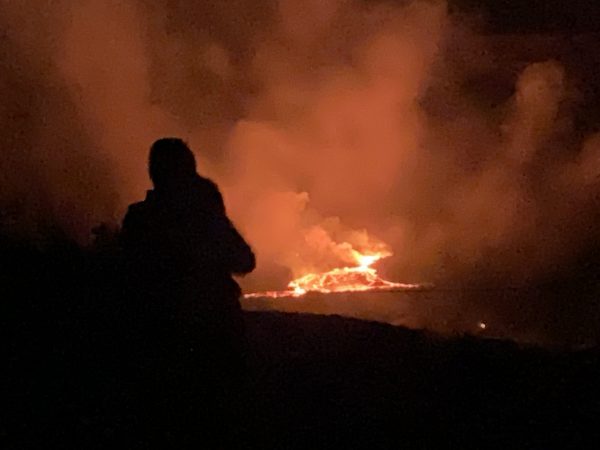
I didn't take much video, and only one still shot. I had to zoom it to x5 or x6 to get any detail, and at that point things are grainy and jump around a lot. If you want to see video, that from a drone is going to be better anyhow.

